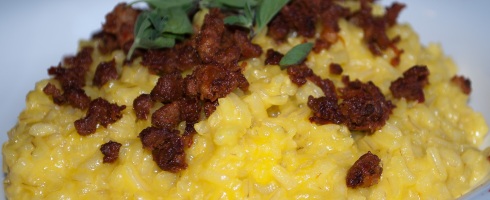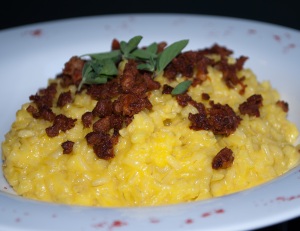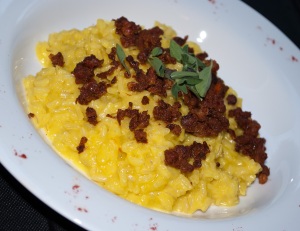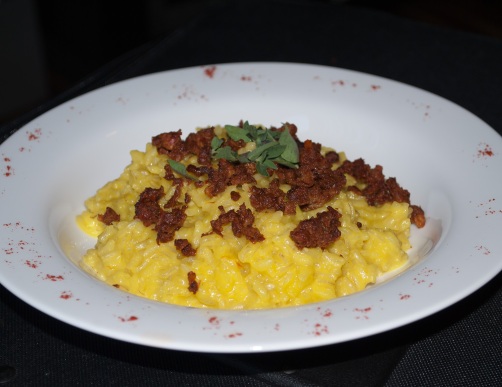For those of you who read my blog, you know that one of my all-time favorite ingredients is saffron. This delicious, but expensive, spice has a unique one-two culinary punch. It has a wonderful hay-like, flowery-honey flavor when used correctly, and it brings a very unique yellow color to whatever it’s cooked with. I use it whenever I get the chance to use it in rice, chicken, or seafood dishes. Shortly after I won the 4thAnnual Marx Foods Morel Blogger Recipe Challenge, I jumped at the chance to enter another Marx Foods challenge, the Marx Foods Integrale Gauntlet. The Gauntlet is a 3 round challenge with the star being Integrale Rice!
Integrale rice is an Italian brown rice that is really not a separate variety of risotto rice, but rather a way of processing the grain so that the rice maintains its raw fiber shell, vitamin B1, B5, B6, proteins and minerals. It is incredibly healthy and only grown and harvested by organic means.
It has a slightly nutty taste and a firmer texture that enhances the “bite” of your risotto! Since this is a contest sponsored by Marx Foods, they kindly sent out 1 kilo of this amazing Integrale rice to use in my recipe!
When I approached the planning of my dish for the contest, I knew that I wanted to use saffron, I really thought that it would complement the nutty flavor of the brown rice, but I wanted to add my own twist, using the Mexican flavors that I love as well. In my mind, I had visions of two different dishes, Risotto Milanese and Paella. Risotto Milanese being a classically rich risotto, made with bone marrow, Parmesan cheese, and of course saffron; and Paella Valencia, the mother of all rice dishes in Spain, made with Spanish Chorizo, seafood, chicken, roasted red peppers, paprika, and finally, of course, the saffron. So, doing a bit of simulation in my head (as all engineers do from time to time), I would use the basic concept of Risotto Milanese and add tequila in place of the white wine, and mix in a bit of the essence of Paella Valencia, somewhat deconstructed, using fresh Mexican chorizo instead of the Spanish chorizo. So what place does Tequila have in a risotto you may ask? I believe that alcohol opens up the rice and prepares it to absorb the liquids introduced into the risotto. So why not use Tequila, and using Añejo Tequila would give the risotto another unique dimension of sweet, “oak-y-ness” flavor once the harsh alcohol cooks off. I would finish off the risotto with a mantecatura of butter and Manchego cheese. Manchego differs from Parmigiano-Reggiano in that it is made from sheep’s milk rather than cow’s milk. The cheese has a well developed, creamy flavor, with a distinctive, but not t0o overwhelming tangy aftertaste that is characteristic of sheep’s milk. It is the mother of all Spanish cheeses, it just sings “Marry me” to the saffron!
So I set about making the chorizo fresh on Monday night. I have a standard recipe that I learned some time ago in Mexico. I also prepared my chicken stock on Monday as well. Having given some time for the chorizo to “cure” a few days to enhance its flavors, it was time to get dirty and get to the challenge! Risotto, once the technique is mastered, is a wonderful way to start a meal, or a stunning side to accompany any protein. Just a sidebar on Integrale rice. It is a slightly different beast, because of the raw grain shell. It takes a bit more stock and a bit more time to cook. I had to use about a cup more stock and I added about 10 minutes of cooking time to get it perfectly al dente. With some constant attention, a bit of pampering, and a shot or two of Don Julio, in about 30 minutes you have a deliciously rich risotto that will be sure to bless any table! Now I call on everyone to support us and go out and vote for this dish on May 30th!
Integrale Milanese “Mexicana”
- 1 ½ cups of Integrale Rice
- 1 clove garlic
- 1/2 medium yellow onion
- 1/3 cup Tequila Añejo
- 2 tablespoons unsalted butter
- 2 tablespoons extra vigin olive oil
- ½ teaspoon saffon
- 1 teaspoon salt
- ½ lb. Mexican Chorizo
- ¼ cup Manchego Cheese
- 5 cups Chicken Broth
- Place the 5 cups of broth in a saucepan and bring to a simmer.
- Add the saffron to the broth and keep very warm.
- Meanwhile, take the chorizo and heat over medium heat and cook for about 10 minutes, breaking it up with a wooden spoon as it cooks.
- Place 2 tablespoons of the olive oil in a large sauté pan over medium-high heat.
- Once it is hot, add the onion and garlic and cook until translucent, but not browning!
- Add the rice and stir with your Girariso to combine.
- Add the Tequila and cook until it is completely absorbed.
- Start adding the stock about 1 cup at a time and stirring constantly until each cup of stock is completely absorbed before adding the next. After 4 cups of stock have been added, start tasting the rice (or about 20 minutes)
- When the rice is al dente, remove from heat and add the remaining 2 tablespoons of butter and the cheese and stir vigorously.
- Plate the risotto and sprinkle with the chorizo. Garnish with fresh parsley or fresh oregano.
- SERVE IMMEDIATELY!














